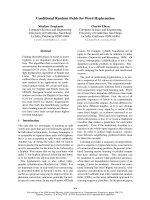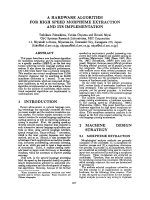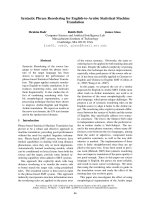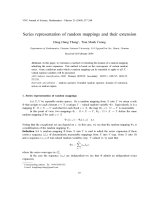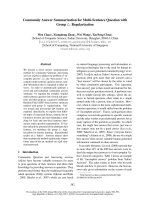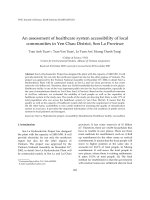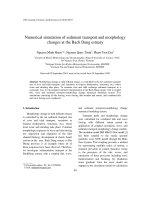Báo cáo "An application of random process for controlled object identification with traffic delay problem " ppt
Bạn đang xem bản rút gọn của tài liệu. Xem và tải ngay bản đầy đủ của tài liệu tại đây (288.47 KB, 7 trang )
VNU Journal of Science, Mathematics - Physics 24 (2008) 101-109
An application of random process for controlled object
identification with traffic delay problem
Vu Tien Viet
∗
Department of Mathematics, Mechanics, Informatics, College of Science, VNU
334 Nguyen Trai, Hanoi, Vietnam
Received 23 January 2007; received in revised form 20 March 2008
Abstract. In the article proposed an effective method estimating transfer function model of
controlled plant including dead-time delay, based on stochatstic time series of input-output
signals. The model structure is modified with parameters optimized until the model error
becomes "white-noise" series that with inough smal auto-correlation function.
1. Propose
The Real signals which occur in the control process always imlpy influences of many random
factors, so the Directive Object Identification Problem is often related to random process.
Mathematically, the Controlled Object Identification problem is the problem that predicts the
trend of Random Process:
y(t)=f (t, u)+v(t) , where t - time; u - vector of non-random input
variables; f(t, u) - regressive function that reflects the trend of non-random process or is the model of
the identification problem; v(t) - random error.
The Theory of Prediction and Identification has been studied and developed with thousands of
scientific works made public since last century. We can find the fundamental results of studies of
statistics and prediction in [1,2], of kinetics system identification in detail in [3,4].
To use linear algebra methods, we often try to change the regressive models into linear com-
bination forms of coefficients:
f(t, u)=
n
i=1
c
i
f
i
(t, u) , where c
i
- parameters, f
i
(t, u) - given
component functions. By using this model, the Parameter Identification Problem can be solved easily.
However, this model is not used to solve the analysis and synthesise problem of systems and we have
to transform this model into the form of sets of state equations (sets of Cauchy differential equations)
or transfer function form. There is a close, easy to exchange relation between set of state equations and
transfer function. The transfer function's model of controlled object is often in the following form:
W (C,s)=
b
0
+ b
1
s + + b
m
s
m
a
0
+ a
1
s + + a
n
s
n
.e
−τs
,m n (1)
where s - complex number, τ 0 - the dead time delay; m, n - degree of numerators and denominators;
C = {τ,b
0
,b
1
, , b
m
,a
0
,a
1
, , a
n
} - vector of parameters to be determined.
In the classic works of identification, all the authors concentrated on developing identification
methods based on pure polynomial fraction models without the dead time delay components (i.e. set
∗
Corresponding author. E-mail:
101
102 Vu Tien Viet / VNU Journal of Science, Mathematics - Physics 24 (2008) 101-109
τ =0). In fact, exists τ =0, we normally try to use approximate polynomial fraction models with
higher degrees of
m, n to increase the model accuracy. With this approach, the object identification
problem without dead time delay is considered to be completely solved in theory [1,4].
In fact, however, applying the pure polynomial fraction methods to the objects with dead time
delay is reluctant and ineffective in controlling technology processes such as energy, metallurgy,
because most of the objects obviously have the dead time delay. To have the necessary model accuracy,
we normally increase the degree of polynomial fraction to a great value, and therefore making the
synthesise problem of systems more complex, even lose its essence.
Disregarding the characteristics of dead time delay of an object is one of the reasons that leads to
a great number of research directions of control theory impractically developed, even caused a "crisis"
in the previous century [5]. To accurately reflect the controlled object, we have to consider dead time
delay as an existing parameter included in the model. Whereas, clearly, the model is non-linear for the
parameters. In this case, classic methods are either ineffective or inapplicable.
Because of the above reasons, in order to increase the applicability, we recommend a controlled
object identification method based on using directly model
(1) along with the dead time delay τ and
other parameters. The following method is based on considering the time response of the object as a
random data series.
2. Estimation of the object model from output response data series
Suppose the controlled object has weight funtion
w(t) with effect input u(t)- predetermined,
output response is measured: y(t)=x(t)+v(t), where v(t)- additive noise (figure 1).
Fig. 1. Linear control system under random effect.
Without loss of generality, we restrict v(t),u(t) being the non-intercorrelation scalars, where
v(t) is White Noise, u(t) is step pulse:
u(t)=
0 when t 0
1 when t>0
(2)
Formerly [3,4], so as to solve the model estimation problem, we based on popular relation
between output response x(t) of object and input signal u(t):
x(t)=
t
0
w(ξ)u(t − ξ)dξ (3)
where w(t) is the weight function.
From (3), we establish the Problem of Defining weight funtion w(t) upon least square condition:
σ
2
=
T
0
y(t) −
t
0
w(ξ)u(t − ξ)dξ
2
dt → min (4)
Vu Tien Viet / VNU Journal of Science, Mathematics - Physics 24 (2008) 101-109 103
and then, define the transfer function W (s) from the weight funtion w(t).
If we parameterize the funtion w(t) in the form of linear combination, the (4) problem will
become linear to coefficients and can be solved easily. However, in this way it is complex to select
component functions and causes the problem bigger, and therefore makes the problem illconditioned.
To avoid this drawback, we recommend directly using the model of transfer function in form
(1) and solve the model estimation problem based on the inverse Laplace transformation. Indeed, if
we consider arguments in the Laplace image domain, we obtain:
X(C,s)=W (C,s).U (s)=
b
0
+ b
1
s + + b
m
s
m
1+a
1
s + + a
n
s
n
.
e
−τs
s
q
.U(s) (5)
where X(s)=L{x(t)} ,W(C,s)=L{w(t)} ,U(s)=L{u(t)}; s - complex variable; L{.}
- notation for Laplace transformation; G(s)=L{g(t)} =
∞
0
g(t)e
−st
dt - Laplace transformation,
from any g(t) function in real domain (g(t)=0, ∀t 0) into corresponding image G(s) in complex
domain.
According to the Inverse Laplace transformation, in [6] we infered a simple formula to compute
time response
x(t) from its Laplace image:
x(C,t)=
1
2πj
+j∞
−j∞
X(C,s)e
st
ds =
2e
t
π
∞
0
P (C,ω) cos(ωt)dω (6)
where - converging abscissa of Laplace integral (if objects are stable, we can select >0 small
enough, for instance =0.01); j
2
= −1 ,P(C,ω)=Re{X(C,ω + j∞)} - the real part of
X(C,ω+ j∞).
Select the upper limit (ω
M
) of the integral which is big enough, then trasform into approximate
sum form, we obtain:
x(C,t)=
2e
t
π
M
r=1
P (C,ω
r
) cos(ω
r
t)[ω
r
− ω
r−1
] (7)
where M - the number of discrete points in frequency range: ω =0÷ ω
M
.
From here, we obtain square error between output response and real data:
σ
2
(C)=
T
0
[y(t) − x(C,t)]
2
dt → min
C
where T - the amount of time to observe the random output data series of real objects.
Regarding the discrete points of time series, we obtain minimization objective function:
σ
2
(C)=
N
i=1
[y(t
i
) − x(C,t
i
)]
2
→ min
C
(8)
where N - the number of discrete points in an interval of observed time: t =0÷T .
Objective function's value σ
2
(C) is determined after a computing process in the following
order: C −→ W (C,+ jω) −→ X(C,+ jω) −→ P (C,ω) −→ x(C,t) −→ σ
2
(C). Therefore,
σ
2
(C) is a computable function and is continuous and differentiable everywhere. On the other hand, is
obvious non-linear functions to parameters and especially have the complex cleft (ravine) characteristic.
With these characteristics, the most effective methods to solve the minimized problem
(8) is to apply
"cleft-over" optimization algorithm [7,8].
104 Vu Tien Viet / VNU Journal of Science, Mathematics - Physics 24 (2008) 101-109
The solution to the (8) problem with the selected structure (m, n, q) of model (1) give us an
optimal estimation
x(C
∗
,t) with y(t
i
) series, and together with the optimal transfer function W (C
∗
,s)
respectively.
3. Determine the optimal estimation model
As above, with each selected struture
(m, n, q), an optimal solution is output response model
x(C
∗
,t) and the W(C
∗
,s) optimal transfer function, respectively. Depending on the selected (m, n, q)
combination, There are infinite structures of the model. So, the facing problem is to find a (m, n, q)
struture so that the corresponding solution to the problem (8) brings out the response x(C
∗
,t), which
is the proper estimation for the
y(t
i
) time series.
According to [1,2], the model is cosidered as a proper estimation if the obtained error series
between the given model and time series become a radom distribution range in the form of "white
noise". Assume a
α significance level, the model is considered to be accurate if correlation coefficients
value r
i
of error series satisfy the followed condition:
|r
i
| u
α
2
/
√
N (9)
where u
α
2
- is the limited value obeying the normal distribution rules, N - the number of data sets of
series.
On the other hand, the
(1) model is fractional, so if we increase the (m, n) degrees its accuracy
will increase as a result. Particularly, q is the nonstatic degree of model, it depends on the behaviour of
output response and is equal to the degree of the asymptote of output response. q =0if the asymptote
of output response is horizontal asymptote. q =1if the asymptote of output response is oblique
asymptote. q>1 if output has no asymptote. In fact, q 1 in most cases.
To define the global optimal estimation model, the steps to solve the identification problem are
as follows:
1. Select the degree of q and fix it from the output response's behaviour.
2. Exploratively select values of denominator's degree n, and values of nominator's degree
m = n −1 simultaneously.
3. For each selected (m, n, q) structure we solve the (8) estimation model problem.
4. With the respective W (C
∗
,s) and x(C
∗
,t) obtained, we determine error series and check
the condition upon model suitability.
5. If the condition is satisfied, the obtained model is optimal and the respective
W (C
∗
,s)
transfer function is the solution to the identification problem.
6. If the model is not suitable, we will select other models with m and n's degree gradually
increased and repeat from step 3.
4. Example
Suppose the output signal of an implement controlled object is the step pulse in form
(2).At
that time, from the output, the measured response signal in form of time series is as follows:
i 1 2345678910
t
i
0.0100 0.2054 0.4008 0.5962 0.7916 0.9870 1.1824 1.3778 1.5732 1.7686
y
i
−0.0023 0.0060 0.2540 0.6000 1.0641 1.3125 1.4700 1.4126 1.2500 1.2191
Vu Tien Viet / VNU Journal of Science, Mathematics - Physics 24 (2008) 101-109 105
i 11 12 13 14 15 16 17 18 19 20
t
i
1.9640 2.1594 2.3548 2.5502 2.7457 2.9411 3.1365 3.3319 3.5273 3.7227
y
i
1.0800 1.0830 1.0127 1.0300 0.9900 1.0310 0.9407 0.9900 0.9600 0.9740
i 21 22 23 24 25 26 27 28 29 30
t
i
3.9181 4.1135 4.3089 4.5043 4.6997 4.8951 5.0905 5.2859 5.4813 5.6767
y
i
0.9500 0.9900 0.9560 0.9960 0.9539 1.0400 0.9680 1.0510 0.9900 1.0211
The Graph of the time series y(t) obtained from experiement is shown in figure 2
Fig. 2. The curve of output response data series of directive object.
We identify the transfer function of object based on model (5) by solving the (8) problem with
different structures. The image of input signal step pulse: U(s)=1/s. The behaviour of the data
series above is corresponding to the nonstatic degree where q =0. Hence, we only have to select the
suitable degree of numerator and denominator (m, n) of transfer function (5). Having selected the
(m, n) structure, we solve the (8) problem by the "cleft-over" algorithm [7,8].
Fig. 3. The error series of models.
106 Vu Tien Viet / VNU Journal of Science, Mathematics - Physics 24 (2008) 101-109
Strutures of tested models:
1. The first struture, we choose: m =0,n=1. The respective optimal model is:
W
1
(C
∗
,s)=
b
0
1+a
1
s
.e
−τs
=
1, 065
1+0, 167s
.e
−0,364s
The error series between the output response x
1
(C
∗
,t) and the measured data is on figure 3-a.
The root-mean-square Error of the model is
σ =0, 1429. By using this model, the estimation is
obviously incorrect because the condition |r
i
| u
α
2
/
√
N is clearly not satisfied.
2. The second struture, we choose: m =0,n=2. The optimal model is:
W
2
(C
∗
,s)=
b
0
1+a
1
s + a
2
s
2
.e
−τs
=
1, 033
1+0, 239s +0, 123s
2
.e
−0,108s
The error series between the output response x
2
(C
∗
,t) and the measured data is on figure 3-b.
The root-mean-square Error of the model is σ =0, 0682. This model brings out the incorrect estimation
because the condition
|r
i
| u
α
2
/
√
N is still not satisfied.
3. With the third struture, we choose: m =1,n=3. The optimal model is:
W
3
(C
∗
,s)=
b
0
(1 + b
1
s)
(1 + a
1
s + a
2
s
2
)(1 + a
3
s)
.e
−τs
=
0, 985(1 + 1, 166s)
(1 + 0, 365s +0, 098s
2
)(1 + 0, 683s)
.e
−0,226s
The error series between the output response x
3
(C
∗
,t) and the measured data is on figure 3-c.
The root-mean-square Error of the model is σ =0, 0342. This model brings out the nearly correct
estimation, the condition upon model suitability |r
i
| u
α
2
/
√
N is nearly satisfied.
4. The fourth struture, we choose: m =2,n=4. The optimal model is:
W
4
(C
∗
,s)=
b
0
(1 + b
1
s + b
2
s
2
)
(1 + a
1
s + a
2
s
2
)(1 + a
3
s + a
4
s
2
)
.e
−τs
=
1, 001(1 + 0, 716s +0, 37s
2
)
(1+0, 202s +0, 084s
2
)(1 + 0, 545s +0, 414s
2
)
.e
−0,183s
The error series between the output response x
4
(C
∗
,t) and the measured data is on figure 3-d.
The root-mean-square Error of the model is σ =0, 0212. This model brings out the correct estimation
since the condition upon model suitability |r
i
| u
α
2
/
√
N is completely satisfied.
While increasing the degrees of m,n of the model, the error series is almost non-decreasing.
In the optimizing process, the old coefficients are almost invariable, whereas the added coefficients -
arising while increasing the degree of model - are always forced to zero by the algorithm. The optimal
solution is nearly at a stand still. According to these results, the transfer function model
W
4
(C
∗
,s)
has error series which is similar to "white noise", and simultaneously yields The root-mean-square
Error minimum. Therefore, we can considered it as the global optimal model of object. The respective
output response of the model is shown on figure 2.
5. Conclusion
1. The objects with dead time delay are popular class of objects in industrial control, its
transfer function has non-linear property for parameters, therefore classic identification methods have
low effectiveness.
Vu Tien Viet / VNU Journal of Science, Mathematics - Physics 24 (2008) 101-109 107
2. Recommending using the transfer function with dead time delay as the basic model and by
using the inverse Laplace transformation we obtain the output response of the model. On this basis,
we solve the object identification problem in the form of the time series estimation problem based on
measured random data of controlled object.
3. The recommended method in this report enable us to solve the directive object identification
problem generally and effectively under the random noise.
4. The optimal model of object determined by the estimation method for non-linear random
model ensures the suitability according to probability and statistic's point of view.
References
[1] G. Christian, A. Monfort, Times Deries and Dynamic Models, Cambridge University Press, 1997.
[2] Nguyen Van Huu, Nguyen Huu Du, Statistic Analysis and Forecast, Hanoi National University Press, 2003. (in Viet-
namese).
[3] P. Eykhoff, System Identification Wiley, 1974.
[4] P. Eykhoff, Trends & Progress in System Identification, Pergamon Press, 1981.
[5] A.A. Krasovski, Summarization of Development History and Situation of the Control Theory, Automation and Industry
Jour., Moscow, No 6-7 (1999) 1. (in Russian).
[6] Nguyen Van Manh, A Frequency Method Calculating the Output Response of a Line Automatic Control System without
Use of H-function Table, Informatic and Control Jour., Hanoi, No 1 (1995) 30. (in Vietnamese).
[7] Nguyen Van Manh, The Affine projection method for solving non-linear optimization problems, Proceeding of NCST
of VietNam, No. 2 (1992) 53.
[8] Nguyen Van Manh, Methods Optimization of Control System for Uncertaint Processes, Dissertation of Science Doctor.
Moscow Power Energy Institute, 1999. (in Russian).

